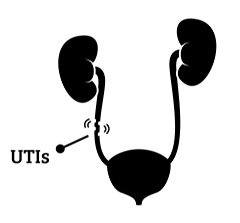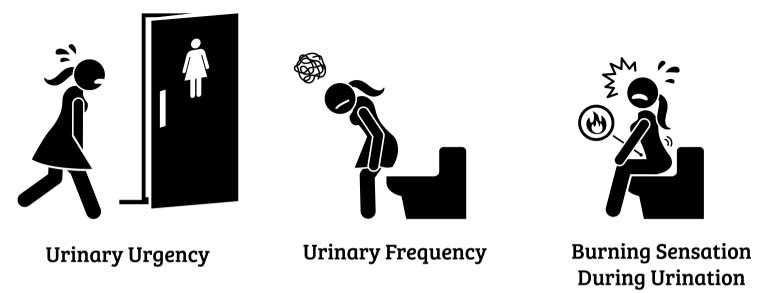
A urinary tract infection, or UTI for short, is when any part of your urinary system becomes infected, including your kidneys, bladder and urethra. A UTI is a lot more common for women as they're at greater risk than men, with it being said that a woman’s chance of getting one in her lifetime is 1 in 2, whereas for men it's just 1 in 10. UTIs can be very painful and annoying to deal with and can cause further serious issues if left untreated, so it's important to know how to recognise a UTI and how to deal with it.
What Causes A UTI?
A UTI is caused by bacteria entering the urinary tract through the urethra (the tube that carries urine out of the body). The bacteria then reaches the bladder and multiplies, causing the infection. The urinary system is designed to block out most bacteria, however, this doesn’t always work. This is because external factors can affect how the bacteria can get to the urinary tract.
Signs Of UTI In Women
There are a number of different ways bacteria can lead to a UTI in women. The first is by the gastrointestinal tract and a type of bacteria called Escherichia coli or E. coli. This bacteria comes from the intestines and out of the anus and can then reach the urethra. This is why doctors say for women to wipe from front to back when they go to the toilet to reduce the risk of this happening.
Another cause of a UTI is sexual intercourse as well as sexually transmitted infections (STIs). This is because the vagina is only a short distance from the urethra so any bacteria can easily spread from one to the other if proper hygiene isn't practised. For this reason, it's also recommended for women to go to the toilet after sexual intercourse in order to flush out the urethra and clear it of any potential bacteria.
Other factors that could put you at a higher risk of developing a UTI include genes and illnesses. For some women, the shape of their urinary tract means they can be more easily affected than others. Additionally, conditions such as diabetes can lead to a weakened immune system, meaning the urinary tract will find it harder to fight off bacteria. Conditions that can affect the urinary flow, such as a stroke and kidney stones, many also put you at a higher risk.
Signs & Symptoms
It's very important that you know how to spot a UTI in order to deal with it as soon as possible. The signs and symptoms of a UTI can be different from person to person and some may not have any at all until a later stage. Here are the most common symptoms of a UTI to look out for:
- A strong and persistent urge to urinate
- A burning sensation when urinating
- Passing small amounts of urine frequently
- Cloudy-looking urine
- Red, bright pink or brown looking urine
- Blood in the urine
- Strong-smelling urine
- Pelvic pain

Types Of UTIs
Depending on the specific part of the urinary system that has been infected, there may be specific additional symptoms to look out for. There are 3 different parts of the urinary tract that could be infected with a UTI - the kidneys, bladder and urethra. Here are some more specific symptoms to look out for to signify one of these:

Kidneys (acute pyelonephritis)
- Upper back and side pain
- High fever
- Shaking and chills
- Nausea
- Vomiting
Bladder (cystitis)
- Pelvic pressure
- Lower abdomen discomfort
- Frequent and painful urination
- Blood in urine
Urethra (urethritis)
- Burning with urination
- Discharge
How to Treat UTI in Women
If you think you have any of the above symptoms of a UTI, then you can go to your doctor and they can perform a urine sample test to check. If they find you do, they'll most likely prescribe a UTI infection treatment in the form of antibiotics. These will usually last for 3 days but can be up to 7 if they think it's more serious.
There are also many UTI home treatments you can try alongside the antibiotics to help. Firstly, make sure to drink plenty of water as this can help with flushing the bacteria out of your system. You can also try pain relief such as paracetamol or a heating pad on the area. There may also be a female UTI treatment over the counter, but you'll need to ask your pharmacist or doctor for advice, especially if you want to go for a UTI treatment without antibiotics.

How To Prevent A UTI
If you want to prevent yourself from getting a UTI, or at least lower your risk of getting one, there are a few things you can do.
Firstly, as the main cause of a UTI is through bacteria spreading from the vagina or anus to the urethra, it's important that you keep the area clean. You can do this by wiping from front to back after going to the toilet and regularly showering and cleaning the area.

Secondly, make sure to empty your bladder when you feel the urge to pee instead of holding it in. Also, if possible, try to go to the toilet after sexual intercourse to flush out any bacteria. You should also keep the genital area clean and dry at all times and try to avoid tight-fitting underwear or clothing that can’t breathe.
Finally, you should add cranberries to your diet. These are full of antioxidants to help protect the area and can also help to fight off bacteria. You can add either the fresh fruit or cranberry juice into your diet, but the best and most convenient seems to be in the form of a natural cranberry supplement, as these will give you the optimum strength and are a lot easier than eating fresh cranberries every day!
Overview
Overall, urinary tract infections are very common in women, so don’t be embarrassed if it happens to you. Just make sure you're aware of the causes of a UTI so that you can reduce your risk of getting one and be aware of the symptoms so that you know what to do if you spot them.

